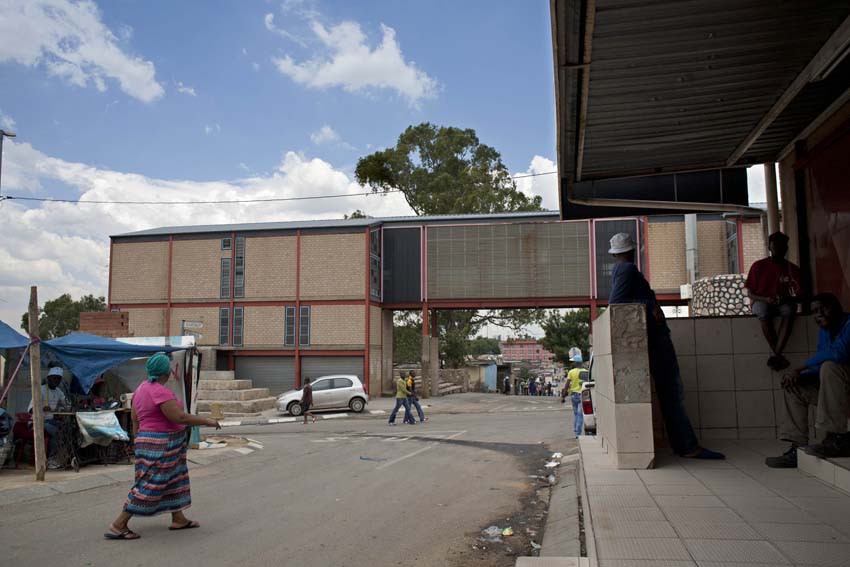
The world pays tribute to Mandela (slideshow)
As South Africans come to terms with the loss of former president Nelson Mandela, the rest of the world bids farewell to Madiba.

Pimples: Saving Madiba's rabbit (video)
Gwede, Mac and Blade try their best to stop the rabbit from whispering in Mandela's ear. But the elusive animal has some tricks up its sleeve.

Zapiro's best Madiba cartoons (slideshow)
From his toughest moments to his most triumphant, Madiba has been an inspiration. Here are some of our favourite Zapiro cartoons about him from 1994 to 2013.

Mandela: SA's greatest son laid to rest (slideshow)
The world watched as Nelson Mandela was finally laid to rest in his hometown of Qunu following a dignified and moving funeral ceremony on Sunday.

The reddish brick house that Nelson Mandela used to rent in the 1940s in Alexandra looks old and dilapidated.
It is located opposite the heritage structure built at the top of Seventh Avenue in the township, 14km from central Johannesburg.
The house – or, to be more precise, a boxed-in dwelling comprising a single divided room – is neither plastered nor painted. It shares a yard, known as the Mandela Yard, with another 14 dwellings.
The dwelling is part of a row of houses in the yard; a sign with the words “Alexandra Heritage Site” hangs on its wall. Some houses are built separately. One stand-alone structure has 46664 spray-painted on its wall – the prison number given to Mandela when he was imprisoned on Robben Island.
Families, including that of the great-great-grandson of John Xhoma, the yard’s late owner, still live there. Xhoma is the man Mandela wrote about in his autobiography, Long Walk to Freedom – he offered the young Madiba a place to stay when he first arrived in Johannesburg.
“Initially,” says former Alexandra councillor Billy Madungandaba, “the plan was to build the heritage centre inside the Mandela Yard, but because of the insufficient space and a court interdict obtained by residents against the authorities not to relocate them from their sites, the project was stopped.”
It is daytime. Most of the houses in the Mandela Yard are locked because the residents are at work. The wooden door of the house Mandela used to rent is wide open, however. A teenaged girl is inside the house, which is crammed with three sofas and a coffee table. A white curtain has been used to divide the space into two rooms – the kitchen and the bedroom.
The girl seems uninterested in talking about the house. She is seated on a couch with a book in her hands; her eyes are fixed on it. She says she is preparing for her grade 10 exams.
The teen stays with her mother, who is away at work. “To me it feels like any other home,” she says when asked how it feels to live where Mandela once stayed. She walks towards the door and says: “I now want to study.” She shuts the door.
Preserving Alexandra's entire history
The Alexandra Heritage Centre on Seventh
Avenue is mainly built of steel and glass. Although construction on the
building started in 2003, it has yet to be completed.
Part of the structure has bricks missing, exposing a small open space. Some panes of glass are broken. The building has ramps to the upstairs entrance, but the door is locked. A few bricks, cigarette butts and used matchsticks litter the ground near the entrance.
It was initially named after Mandela but Zodwa Tlale, co-ordinator of the Alexandra Heritage Association, says the centre was later rechristened “Alex”, as the 102-year-old township is affectionately known.
That was after the association lobbied for the centre to reflect the history of Alexandra, and not just Mandela as an individual.
Watch: Madiba’s Alexandra legacy abandoned
“Mandela is just part of that history,” says Tlale, who stresses the importance of preserving the entire history of the township, “including the Mandela part”.
She is speaking in a spacious room at the San Kopano multipurpose community centre on 12th Avenue. She used to work for the heritage centre as a co-ordinator and says it has space to house a music archive as well as archives documenting the history of Alexandra and Mandela.
She attributes the disruption in the building of the centre to a shortage of funds for the project. The initial budget was R6.7?million, but it shot up because of an unforeseen increase in steel prices, according to Tlale.
She says it was initially envisaged that it would be completed by 2007.
Residents say they are concerned that the building has become a hideout for criminals who ambush unsuspecting passers-by at night.
A burly man who runs a gym from his home, Tumi Masiti (29), is the centre’s immediate neighbour. He says there have been cases of cellphone robbery and rape there.
Some boys, he says, smoke nyaope in the vicinity. “There used to be security guards, but they would rent out the place to the homeless to sleep [in] and we, as people of Alex, chased them away.”
'Strong interdict' preventing demolition
In front of one house in the Mandela Yard
is a notice board that reads, in part: “It is therefore proposed to [be]
developed and conserved as a heritage precinct to include renovations to the
room occupied by Nelson Mandela in the 1940s, [and] construction of a small
exhibition facility that will include tourism and community facilities.”
Tlale says the houses in the yard should not be destroyed “because they form part of Alex’s heritage”. She says there is a “very strong interdict obtained by residents” to prevent the authorities from pulling down the houses.
She equates the mooted demolition with getting rid of the township’s history. “We don’t have a problem with shacks in the township being demolished, but the houses should be left alone.”
For 46 years Matshele Bopape (93) has lived in a house next to where Mandela once lodged. She remembers how he used to visit the place long after he had retired as president.
She is seated on a chair in her kitchen, which houses a four-plate electric stove. She eats beetroot from a bowl. She refuses to allow pictures to be taken, because “too many tourists” who come to view the place have photographed her.
She recounts how Mandela met Xhoma at Johannesburg’s Park Station in the early 1940s, and how Xhoma had helped him with accommodation “because he was also Xhosa-speaking”.
Bopape is not aware of plans to relocate residents of the yard to make way for a museum in Mandela’s honour.
She says the mural of Mandela on the wall outside her house misrepresents the “old man”. The artist made him “look ugly” in the picture, she maintains.
Hazel Motlana (52) lives in a nearby shack. She's watching television and having her breakfast of bread and tea. She says, “We were told about six years or so ago that the government wants to build a museum at the place where Mandela used to live.”
Motlana says the residents were not told the exact date on which the museum would be erected. “I have always wanted to build a brick house and demolish this shack,” she says, “but I can’t because I might be told to make way for the Mandela museum in the future.”
Suspected misappropriation of funds
In 2008 Fana Sihlongonyane, director of the
planning programme in the school of architecture and planning at the University
of the Witwatersrand, wrote in an essay entitled The Nelson Mandela Museum and
the Tyranny of Political Symbols: “The use of the struggle memory by the South
African government is inconsistent with the global trend, whereby public memory
forms part of the cultural capital for promoting urban development.”
The plans to build a Mandela museum in Alexandra, he says, were part of “the Alexandra Renewal Project to demolish shacks in Alex and build RDP houses to the tune of R1.3?billion”. It began in 2001, after then-president Thabo Mbeki announced a wide-ranging urban renewal project to initiate infrastructure development in townships.
In Alexandra, the project would entail shacks being demolished and replaced by RDP houses.
According to Sihlongonyane, the Gauteng Tourism Authority, the Alexandra Renewal Project, the department of environmental affairs and tourism and the department of arts and culture led the Mandela museum project.
He was particularly concerned that residents had been evicted from the site where the heritage centre was to be built and moved to Bramfisherville, before the interdict was obtained. Sihlongonyane said more than 40 families were relocated.
A lanky and tattooed tavern owner, Moss Maleka, runs his business next to the Mandela Yard. He says the place was a hive of activity after the news of Mandela’s death broke last December. The hype has since died down and Maleka says one rarely sees buses full of people who want to view the place.
“Most people look surprised after they have been to the place,” says Maleka. “There is nothing fascinating about the place. I don’t know what they actually expect to see when they come here – some would stay for two minutes and leave.”
Like Maleka, many residents say they don’t know why the project stalled, but they suspect it could be the result of financial misappropriation. He says the place is nothing compared with the Hector Pieterson Museum in Soweto, which attracts many tourists daily.
Maleka continues: “I grew up in Alex and I know how this place has the potential to attract tourists and boost our businesses here.”
Rapula Moatshe is a Eugene Saldanha fellow, sponsored by the Charities Aid Foundation Southern Africa. “There is nothing fascinating about the place. I don’t know what they actually expect to see when they come here – some would stay for two minutes and leave.” – Mail & Guardian

